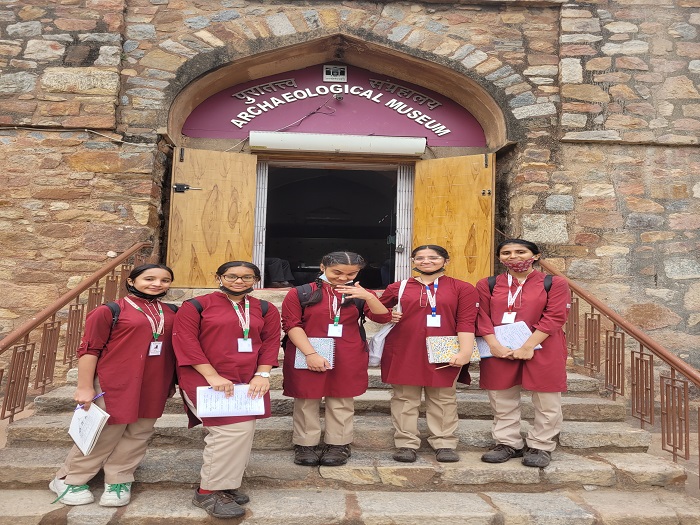INTACH excursion to ASI Purana Quila excavation site
"Tourists in Delhi often witness the Mughal and colonial layers of history, but Delhi is much older than that. Unfortunately, not many people are aware of its ancient origins. While many believe that Delhi was first settled in the 11th century, our research dates back to before 800 BCE. Purana Qila is the only place where you can witness the rich history of Delhi spanning 2,500 years."
Students from classes 8, 9, and 12 were invited by INTACH (Indian National Trust for Art and Cultural Heritage) to participate in a learning excursion on May 1st, 2023, at the Old Fort excavation site of the Archaeological Survey of India (ASI).
INTACH is recognized as one of the world's largest heritage organisations, with over 190 chapters across the country. Its mission is to preserve both tangible and intangible heritage, and it organises various programmes and activities throughout the academic year to encourage students to learn about and conserve their heritage.
The weather was perfect for an outdoor educational experience, allowing the students to gain insights into archaeology, the functioning of ASI, and the preservation of archaeological findings. The site at the Old Fort has undergone multiple excavations in the past, prompted by references in historical records to a city that once existed between Humayun's Tomb and the fortress built by Feroz Shah Tughluq. The most recent excavation took place in 2017-2018, and the ASI has now resumed excavations with the hope of discovering more painted artefacts from the Mahabharata period.
This archaeological journey can be traced back to the work of the late Padma Vibhushan-winning archaeologist B.B. Lal. In 1954 and then from 1969-73, Lal conducted pioneering and extensive excavations within the grounds of Purana Qila, linking the site to the Mahabharat period. The antiquity of this location can be traced back to that era. The reference to Inderpath or Indraprastha (an ancient city within the fort walls) is not only mentioned in ancient Indian literature but also in Persian literature. It is one of the five places that the Pandavas desired.
[gallery link="file" order="DESC"]
Lal claimed that Purana Qila is the "Pandava kingdom of Indraprastha." While there is no direct or conclusive evidence connecting the fort to the text, the discovery of painted grey pottery at sites mentioned in the legend, including Purana Quila, indicates the existence of a flourishing culture dating back to 600-1200 BCE. This revelation led to the period being officially termed the Painted Grey Ware (PGW) culture.
During this fascinating endeavour, the students learned about how ASI assesses potential excavation sites, the various types of excavations conducted (including vertical and slope excavations), and the findings that provide a cultural chronology spanning up to 2400 years. Previous findings indicated that the carbon dating of the artefacts dated the PGW culture to 1200-800 BCE. However, as Lal himself admits, the mere presence of a PGW culture at the sites mentioned in the epic does not automatically prove the historical accuracy of the story. It merely suggests cultural interconnections between these sites.
Some of the artefacts discovered in the last excavation, such as sickles, terracotta toys, kiln-burnt bricks, beads, coins, terracotta figurines, and seals, are currently on display at the Archaeological Museum within the Purana Qila Fort Complex.
One of the objectives of the current excavation is to preserve and safely expose the previously dug-up trenches. Moreover, there is a significant hope of uncovering traces of even older painted grey ware artefacts.
During the excavation conducted in 2013-2014, pottery found in a stratified layer in a flood area traced its origins back to the pre-Mauryan period. The term "flood area" refers to an area covered with silt discovered during the previous dig, which, upon further examination, was identified as evidence of a past flood.
The excavation findings, including amulets, coins, pottery from the Rajput and Gupta periods, and distinctions between the two, were showcased to the students. The archaeologists revealed that they have also discovered traces of industrial activity, particularly cultivation, which were not found during B.B. Lal's time. Cultural deposits from the Maurya to Shunga, Kushana, Gupta, Rajput, Sultanate, and Mughal periods were unearthed, along with artefacts from the transitional period.
The future remains uncertain as to whether the city of Indraprastha will be discovered or if the confirmed presence of a PGW-era settlement will be found. However, it is safe to conclude that this site holds immense historical and cultural significance, offering us a glimpse into the past. Therefore, the anticipation of uncovering another chapter in the "History of Delhi," potentially extending it back by another 300 years, is certainly worth the wait.













